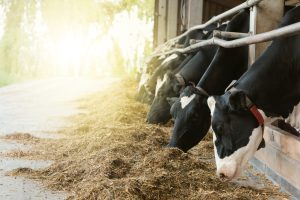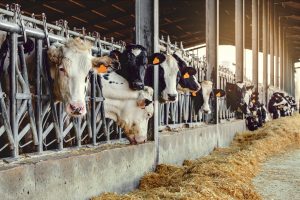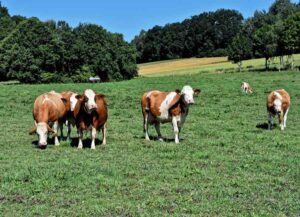Álvaro García
In modern livestock production, the discussion of greenhouse gases (GHG) and nutrient excretion often comes framed as a purely environmental problem. Methane emissions from ruminant eructation and ammonia volatilization from excreta are cited as threats to climate stability and local ecosystems. While these environmental concerns are valid, they mask an equally important truth: methane and ammonia also represent lost nutrients and money.
The emerging concept of ENVIRONOMICS seeks to place a clear economic value on these involuntary nutrient losses. By translating emissions into units of lost feed energy or wasted protein, producers and advisors can better understand how environmental inefficiency undermines farm profitability. This article examines two major nutrient losses, methane in eructation and ammonia in excreta, and frames them in economic terms relevant to cattle production systems.
Methane from eructation: Lost energy
Methane is produced during rumen fermentation as archaea utilize hydrogen generated by microbial digestion of feed. The process helps maintain redox balance in the rumen, but the gas itself carries energy that is expelled into the atmosphere rather than captured by the cow.
How much energy is lost?
Research consistently shows that 2 to 12 percent of gross energy intake (GEI) in ruminants is lost as methane. For a high-yielding dairy cow consuming 25 kg of dry matter at 6.8 MJ NEL/kg, this equates to approximately:
- Gross energy intake: ~170 MJ/day
- Methane loss (6% GEI average): ~10 MJ/day
- Equivalent lost milk energy: ~3 liters of milk
That is energy purchased and fed but never monetized.
Economic translation
At current milk values (e.g., 0.15–0.20 USD per liter), methane loss represents $0.45–$0.60 per cow per day. Across a 1,000-cow dairy, this scales to $160,000–$220,000 annually. For beef cattle, the cost is embedded in slower growth rates and longer days on feed.
Mitigation and environomic opportunity
Feed strategies to reduce methane, such as improved forage digestibility, fat supplementation, or additives like 3-nitrooxypropanol (3-NOP; BOVAER), can improve feed conversion efficiency. Environomics reframes mitigation not as compliance with emission targets but as capturing lost milk or beef production. Every gram of methane avoided means more energy available for saleable product. While methane represents a loss of dietary energy, ammonia reflects a parallel inefficiency in protein utilization. Together, they highlight the two most significant nutrient drains in ruminant production systems.
Ammonia from excreta: Lost protein
Unlike methane, which represents lost energy, ammonia is a by-product of inefficient nitrogen utilization. Dietary protein not captured in milk or muscle is excreted, primarily as urea in urine. When this urea hydrolyzes, ammonia volatilizes into the environment.
In dairy systems, typically only 25 to 35 percent of dietary nitrogen is secreted in milk. The rest is excreted, and a large fraction volatilizes as ammonia. Consider a dairy cow consuming 25 kg DM/day at 16% crude protein:
- Protein intake: 4.0 kg/day
- Nitrogen intake: 640 g/day
- Milk nitrogen output (30% efficiency): ~190 g/day
- Nitrogen wasted: ~450 g/day.
This wasted nitrogen corresponds to approximately 2.8 kg of protein lost per cow per day.
With soybean meal priced around $600/ton (0.60 USD/kg), this loss equals $1.50–$2.00 per cow per day in protein not monetized. Over 1,000 cows, the cost exceeds half a million USD annually.
Modeled example: Economic impact of mitigation strategies
While methane and ammonia losses are well quantified, the potential economic savings from mitigation can be illustrated through a simple modeled example. The table below estimates daily and annual cost recovery for a 1,000-cow dairy herd implementing selected mitigation strategies.
Modeled Economic Savings from Nutrient Loss Mitigation Strategies in Dairy Cows | |||
Mitigation strategy | Estimated reduction | Daily savings per cow | Annual savings (1,000 cows) |
3-NOP feed additive (methane reduction) | 30% less methane | $0.15/day (recovered milk energy) | $55,000/year |
Precision protein balancing (RDP vs. RUP) | 10% less nitrogen loss | $0.20/day (protein savings) | $73,000/year |
Phase feeding + synthetic amino acids | 15% less nitrogen loss | $0.30/day (protein savings) | $110,000/year |
Note: Values are illustrative estimates based on typical feed costs and emission reductions. Actual results will vary with herd size, diet composition, and market prices. | |||
Mitigation and the environomic framework: Turning nutrient losses into economic and environmental gains
Strategies such as precision protein balancing (optimizing the ratio of rumen degradable protein [RDP] to rumen undegradable protein [RUP]), phase feeding, and the inclusion of synthetic amino acids represent practical approaches to enhance nitrogen efficiency. These nutritional interventions allow the cow to better match dietary supply with metabolic demand, reducing excess nitrogen excretion and improving overall feed utilization.
From an environomic perspective, the reduction of ammonia losses goes beyond fulfilling regulatory or environmental goals. It directly translates into the recovery of value from expensive protein supplements that would otherwise be lost through volatilization or excretion. Each gram of nitrogen retained in milk or muscle instead of being lost as waste represents both a mitigation of environmental burden and a tangible economic return.
At the same time, methane and ammonia illustrate two interconnected dimensions of inefficiency: energy and protein that are paid for but never transformed into saleable product. Methane represents an energetic drain, while ammonia reflects a loss of dietary nitrogen potential. Together, they highlight the hidden cost of involuntary nutrient elimination, a dual challenge where environmental emissions align with economic inefficiencies.
The environomic framework therefore underscores the importance of integrated mitigation strategies that simultaneously address productivity, profitability, and sustainability. By reframing nutrient losses as lost revenue streams rather than inevitable byproducts, producers can view mitigation not as a cost of compliance, but as an opportunity to capture unrealized value while contributing to environmental stewardship.
Nutrient Losses in Dairy Cows and Mitigation Potential | ||||
Nutrient loss | Biological origin | Typical magnitude | Economic impact | Mitigation potential |
Methane (CH₄) | Rumen fermentation (hydrogen sink) | 2–12% of gross energy | 1–3 liters of milk lost per cow per day | Up to 30% reduction (feed additives, improved forage); ~$0.15–$0.20/day recovered |
Ammonia (NH₃) | Protein not captured in milk/meat, excreted as urea | 60–70% of dietary N | $1.50–$2.00 protein lost per cow per day | 10–20% reduction (precision protein feeding, amino acids); ~$0.20–$0.30/day recovered |
Note: Mitigation values are approximate and depend on diet composition, herd management, and technology adoption. | ||||
By quantifying both losses in monetary terms, environomics provides a common language for nutritionists, producers, and policymakers. Rather than presenting emission reductions as abstract climate goals, they can be reframed as profit recovery measures.
Practical implications for producers
- Feed efficiency is environmental efficiency. Cows that convert feed more efficiently inherently produce less methane and ammonia per unit of milk or meat.
- Precision feeding saves twice. Balancing protein and energy not only reduce emissions but also cuts input costs.
- Investment in mitigation can pay back. Technologies such as 3-NOP or urease inhibitors may appear costly, but when calculated against lost nutrients, the return on investment becomes evident.
- Benchmarking is key. Producers should measure or model their own emission losses to identify where environomic opportunities lie.
Conclusion
Methane and ammonia are not simply pollutants; they are tangible signs of lost efficiency and wasted feed dollars. By adopting an environomic perspective, producers can see environmental stewardship not as an imposed cost, but as a route to greater profitability. The cow that emits less methane and excretes less ammonia is not only better for the planet—it is also better for the farm’s bottom line.
Environomics bridges nutrition, environment, and economics. It provides a framework where sustainability and profitability align, reminding us that every unit of nutrient conserved is both an environmental win and a business advantage.
© 2025 Dellait Knowledge Center. All Rights Reserved.









